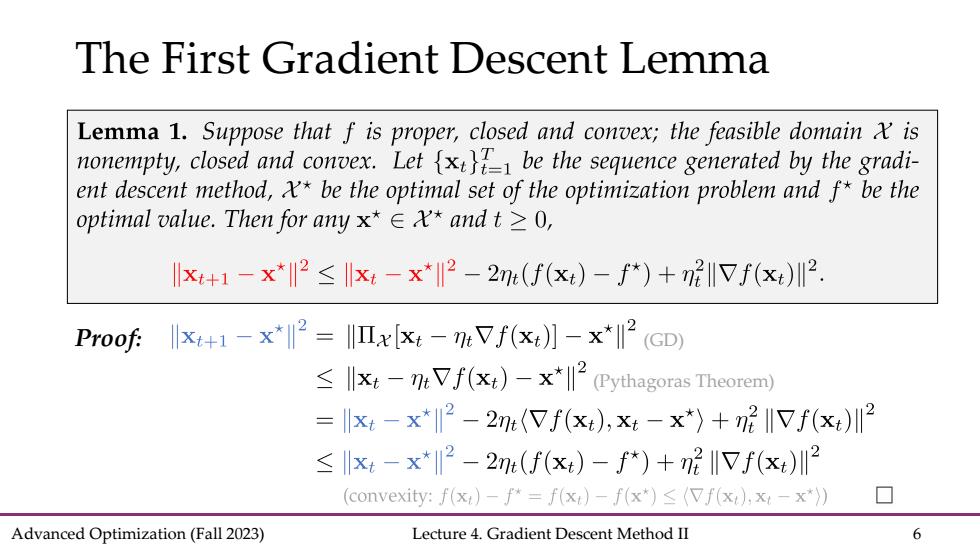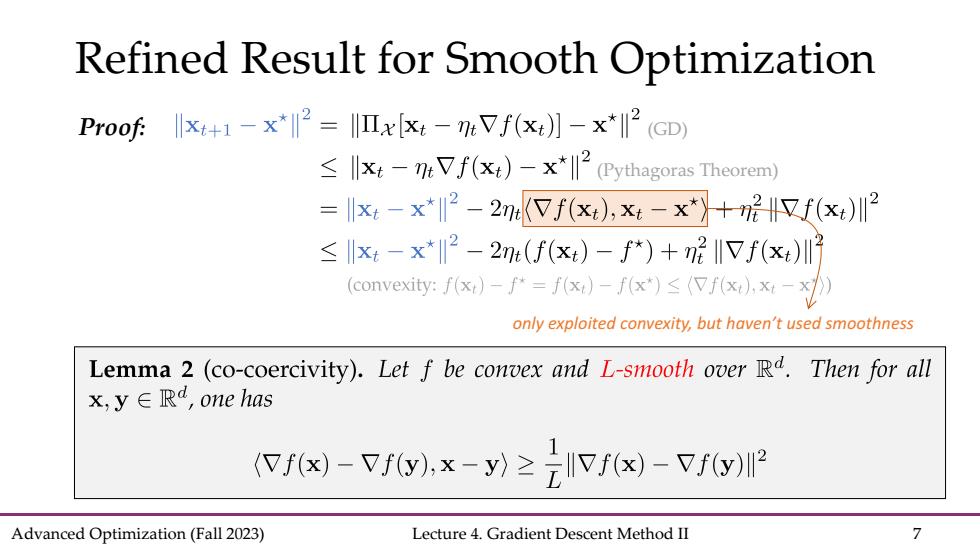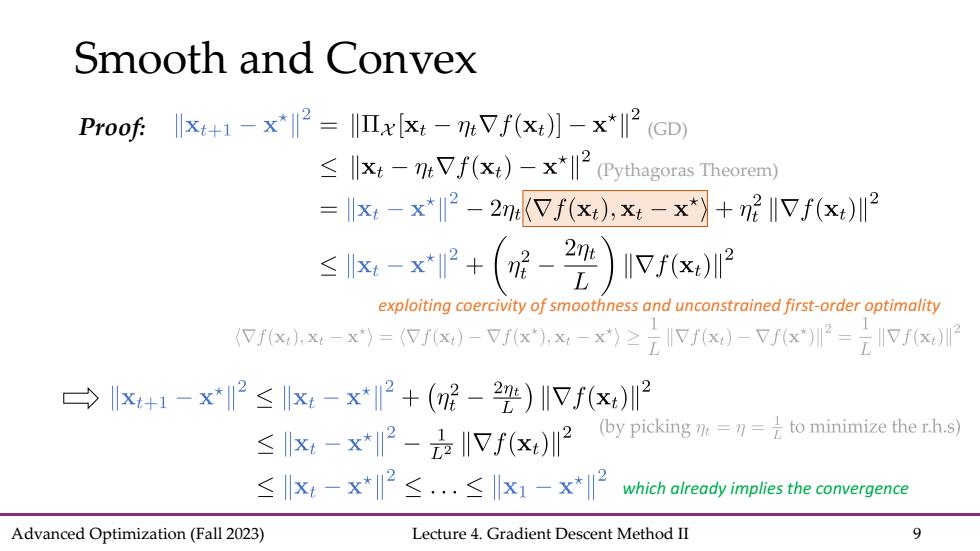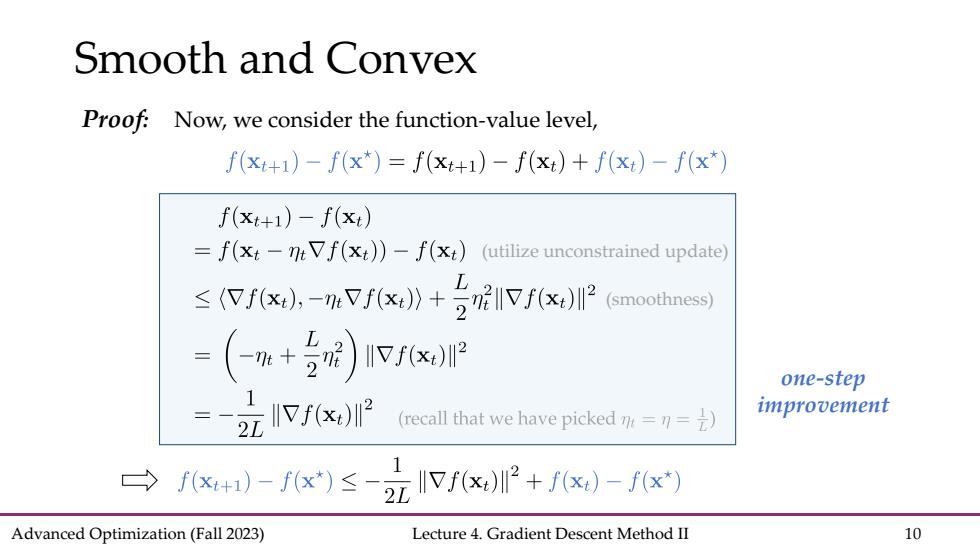
The First Gradient Descent Lemma Lemma 1.Suppose that f is proper,closed and convex;the feasible domain is nonempty,closed and convex.Letxbe the sequence generated by the gradi- ent descent method,x*be the optimal set of the optimization problem and f*be the optimal value.Then for any x*∈X*andt≥0, Ix+1-x*2≤x-x*2-2n(f(x)-f*)+m2IVf(x)川2. Proof:+x2=x[-mVf(x)-*(GD) llxt-nVf(xt)-x*2 (Pythagoras Theorem) llx:-x*ll2-2m(Vf(x:),x:-x*)+nVf(x)12 ≤川xt-x*2-2n(f(x)-f*)+m2IVf(x)川2 (convexity:f(x:)-f*=f(x)-f(x*)(Vf(x),x:-x*)) Advanced Optimization(Fall 2023) Lecture 4.Gradient Descent Method II 6
Advanced Optimization (Fall 2023) Lecture 4. Gradient Descent Method II 6 The First Gradient Descent Lemma Proof: (Pythagoras Theorem) (GD)

Refined Result for Smooth Optimization Proof x1-x2=Ixx:-nVf(x)]-x*l2 (GD) ≤小x4-0eVf(xt)-x*l2(Pythagoras Theorem) =xt-x*2-2eVf(x),xt-x*+呢H又f(x)2 ≤x-x*2-2m(f(x)-f*)+m2IVf(x)川7 (convexity:fx)-f=fxt)-fx*)≤(7f(xt,x-x》 only exploited convexity,but haven't used smoothness Lemma 2 (co-coercivity).Let f be convex and L-smooth over Rd.Then for all x,y∈Rd,one has (Vf(x)-Vf(y),x-y)2f(x)-Vf(y) Advanced Optimization(Fall 2023) Lecture 4.Gradient Descent Method II 7
Advanced Optimization (Fall 2023) Lecture 4. Gradient Descent Method II 7 Refined Result for Smooth Optimization Proof: (Pythagoras Theorem) (GD) only exploited convexity, but haven’t used smoothness

Co-coercive Operator Lemma 2 (co-coercivity).Let f be convex and L-smooth over Rd.Then for all x,y∈Rd,one has (Vf(x)-Vf(y).x-y)zlVf(x)-Vf(y) Definition 1(co-coercive operator).An operator C is called B-co-coercive(or B-inverse--strongly monotone,,forB>0,if for any x,y∈孔, (Cx-C,x-≥3Cx-CI2. The co-coercive condition is relatively standard in operator splitting literature and variational inequalities. Advanced Optimization(Fall 2023) Lecture 4.Gradient Descent Method II 8
Advanced Optimization (Fall 2023) Lecture 4. Gradient Descent Method II 8 Co-coercive Operator The co-coercive condition is relatively standard in operator splitting literature and variational inequalities

Smooth and Convex Proof:-x=Ix [:-mVf()]-x*2 (GD) llxt-nt Vf(xt)-x*(Pythagoras Theorem) =xt-x*2-2meVf(x),x-x*》+n呢I7f(x)I2 ≤x-xP+(-2) Vf(x)I2 exploiting coercivity of smoothness and unconstrained first-order optimality (fx,x4-x*)=(fx)-Vf(x),x-x)≥元IVf6x)-Vf6x*)川2=Vf(x)2 →x+1-x*2≤x-x*2+(2-22)I川Vf(x)2 ≤x-x*2-2IVf(x)2 (by picking=刀=是to minimize ther.h.s) ≤x4-x*2≤.≤x1-x*2 which already implies the convergence Advanced Optimization(Fall 2023) Lecture 4.Gradient Descent Method II 9
Advanced Optimization (Fall 2023) Lecture 4. Gradient Descent Method II 9 Smooth and Convex Proof: (Pythagoras Theorem) (GD) exploiting coercivity of smoothness and unconstrained first-order optimality which already implies the convergence

Smooth and Convex Proof:Now,we consider the function-value level, f(x+1)-f(x*)=f(xt+1)-f(xt)+f(x)-f(x*) f(x++1)-f(x) =f(xt-ntVf(xt))-f(xt)(utilize unconstrained update) ≤fx,-Vfx》+5呢IVf0x (smoothness) =(-e+)Ifx训e one-step 2元fx2 (recall that we have picked m=n=1) improvement f-fx≤克fP+)-fx Advanced Optimization(Fall 2023) Lecture 4.Gradient Descent Method II 10
Advanced Optimization (Fall 2023) Lecture 4. Gradient Descent Method II 10 Smooth and Convex Proof: Now, we consider the function-value level, one-step improvement (smoothness) (utilize unconstrained update)